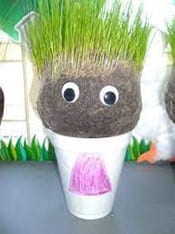We all have felt like we are just surviving in life, it is a natural feeling. It isn’t always the picture perfect image from a storybook we have for our family, but for some this is not just a temporary stop on the journey of life. For some families, this is a way of life day in and day out that causes stress, anxiety and other health concerns on both caregivers and children. Do we as 4-H volunteers know i our families are surviving or thriving when they come to meetings? According to www.TalkSooner.org, there are several characteristics of a Thriving Family, but we will focus on two of those: quality family time and positive supportive adults for caregivers and children.
4-H club meetings can provide both of those supportive characteristics for our families. What better time to get a family to be focused on each other and experiencing quality family time then engaging Cloverbuds and caregivers in an activity that has them working together at a club meeting. An activity that allows for creativity and flexibility is a win-win for engaging caregivers and children in collaboration. Designing your family shield is a good activity that includes writing and drawing components. A family shield can be printed or downloaded from the following link. https://www.nga.gov/content/dam/ngaweb/Education/learning-resources/lessons-activities/greco-roman-myths/coat-of-arms.pdf. The shield should have four sections and a banner across the bottom where you can list your family name. Caregivers and children should complete one section on the shield for each of the following prompts:
- People we Love (Make a list)
- Family Fun (Draw a picture)
- People that we can Count on (Make a list)
- How our Family Communicates (Pictures or a list)
4-H volunteers should be a positive adult role model that supports youth in their club and encourages children to explore their interests and learn new skills. As 4-H volunteers you can also be that supportive adult that a Cloverbud caregiver might need in their life to move their family from surviving to thriving. Engage caregivers in the Cloverbud experiences during your club meetings on a quarterly schedule or provide time for them to talk with another 4-H volunteer while at the club meeting. I think you can agree that we all can use another supportive adult in our lives and someone else “in your corner” when life throws you a curve ball.
Source: TalkSooner.org. (n.d.). About the thriving families campaign and the Northwest Quadrant. Retrieved on November 15, 2022, from https://talksooner.org/thrivingfamilies/
 What is a spark and why would you want to search for it? A spark is something that you love to do, something that gets you excited, something that you are good at or something that energizes you. Maybe you have already identified a spark in your life, as most of us have many sparks that get us excited and ready to jump into action. Cloverbuds might have already identified a spark through school, sports, or family experiences. 4-H provides another opportunity for them to have new experiences and participate in new events that can help them discover new sparks! Sparks are interests, skills, talents, and special qualities that can emerge while youth are experiencing 4-H after school programs, 4-H community club events, or special interest clubs.
What is a spark and why would you want to search for it? A spark is something that you love to do, something that gets you excited, something that you are good at or something that energizes you. Maybe you have already identified a spark in your life, as most of us have many sparks that get us excited and ready to jump into action. Cloverbuds might have already identified a spark through school, sports, or family experiences. 4-H provides another opportunity for them to have new experiences and participate in new events that can help them discover new sparks! Sparks are interests, skills, talents, and special qualities that can emerge while youth are experiencing 4-H after school programs, 4-H community club events, or special interest clubs.

